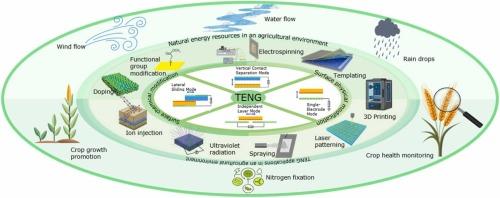摩擦电纳米发电机的最新进展:为智能农业的未来提供动力
IF 17.1
1区 材料科学
Q1 CHEMISTRY, PHYSICAL
引用次数: 0
摘要
在大数据、物联网(IoT)和人工智能(AI)进步的推动下,智能农业的出现需要高效、可持续和自主的能源解决方案,为智能农业的关键传感器和设备提供动力。传统能源,如电池和有线电力系统,有几个挑战,包括有限的寿命,环境问题和复杂的安装程序,特别是在偏远的农业环境中。摩擦电纳米发电机(TENGs)提供了一种很有前途的替代解决方案,通过从可用的自然资源(如雨、风和水流)中捕获低频机械能来产生电能。TENG的工作原理是基于接触通电(CE)和静电感应(EI)的综合效应。然而,TENG在推动智能农业技术方面的探索有限。本文全面讨论了高性能teng的工作机制、运行模式和材料工程策略,并特别关注了它们在智能农业技术中的意义。综述了腾达利用农业环境中可自由获取能源的不同途径,并详细讨论了相关机制。简要综述了近年来TENG技术在固氮、促进作物生长和农业环境监测等方面的应用进展,并讨论了TENG技术在智慧农业中的优势。最后,对未来推进teng辅助智慧农业技术的研究方向提出了战略建议。本文章由计算机程序翻译,如有差异,请以英文原文为准。

Recent progress in triboelectric nano-generators: Powering the future of smart agriculture
The emergence of smart agriculture, driven by advancements in big data, Internet of Things (IoT), and Artificial Intelligence (AI), necessitates efficient, sustainable and autonomous energy solutions to power the sensors and equipment critical for smart farming. Conventional energy sources, such as batteries and wired power systems, have several challenges, including limited lifespan, environmental concerns, and complex installation procedures, especially in remote agricultural environments. Triboelectric Nanogenerators (TENGs) offer a promising alternative solution for generating electrical energy by capturing low-frequency mechanical energy from available natural sources such as rain, wind and water flow. TENG operates based on the combined effect of contact electrification (CE) and electrostatic induction (EI). However, there is limited exploration of TENG in powering smart agriculture technologies. This comprehensive review discusses the working mechanism, operational modes, and material engineering strategies employed to develop high-performance TENGs, with special focus on their significance in smart agricultural technologies. Different approaches used by TENGs to harness freely available energy from agricultural environments are summarized, and related mechanisms are discussed in detail. A brief overview of the recent development of the TENG application for nitrogen fixation, crop growth promotion and agricultural environmental monitoring is discussed, and the benefits of TENG technology for smart agriculture are discussed. Finally, the conclusions and strategic recommendations for future research directions for advancing TENG-assisted smart agriculture technologies are proposed.
求助全文
通过发布文献求助,成功后即可免费获取论文全文。
去求助
来源期刊

Nano Energy
CHEMISTRY, PHYSICAL-NANOSCIENCE & NANOTECHNOLOGY
CiteScore
30.30
自引率
7.40%
发文量
1207
审稿时长
23 days
期刊介绍:
Nano Energy is a multidisciplinary, rapid-publication forum of original peer-reviewed contributions on the science and engineering of nanomaterials and nanodevices used in all forms of energy harvesting, conversion, storage, utilization and policy. Through its mixture of articles, reviews, communications, research news, and information on key developments, Nano Energy provides a comprehensive coverage of this exciting and dynamic field which joins nanoscience and nanotechnology with energy science. The journal is relevant to all those who are interested in nanomaterials solutions to the energy problem.
Nano Energy publishes original experimental and theoretical research on all aspects of energy-related research which utilizes nanomaterials and nanotechnology. Manuscripts of four types are considered: review articles which inform readers of the latest research and advances in energy science; rapid communications which feature exciting research breakthroughs in the field; full-length articles which report comprehensive research developments; and news and opinions which comment on topical issues or express views on the developments in related fields.
 求助内容:
求助内容: 应助结果提醒方式:
应助结果提醒方式:


